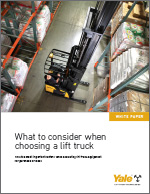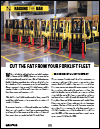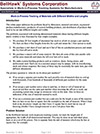Whitepapers
Materials Handling
FILTER BY CATEGORY
- 3PL
- 4PL & LLP
- Automation
- Barcode & RFID
- Bulk
- Canada Logistics
- Chemical Logistics
- Cold Chain Logistics
- Customs Compliance & Duty Drawback
- Data Analytics
- Data Management
- Demand Planning & Forecasting
- Distribution Center Management
- Drayage
- E-Commerce
- Education
- Finance
- Fleet Management
- Food Logistics
- Freight Forwarding
- Freight Payment, Audit & Billing
- Fulfillment / eFulfillment
- Global Logistics
- Global Trade
- HazMat
- Intermodal
- Labor Management
- Last Mile / Final Mile
- Lift Trucks / Forklifts
- Logistics IT
- Materials Handling
- Moisture & Temperature Control
- Ocean
- Package Delivery
- Packaging
- Parcel
- Ports
- Printers & Labels
- Rail
- Real Estate
- Refrigerated Warehousing
- Retail
- Retail Logistics
- Reverse Logistics
- Risk Management
- Robotics
- Routing, Scheduling & Shipping Technology
- Security Solutions
- Site Selection
- Small Package Services
- Sourcing & Negotiations
- Supply Chain Execution
- Supply Chain Management & Optimization
- Supply Chain Mgmt/Optimization
- Sustainability
- TMS
- Transportation
- Transportation & Freight Management
- Trucking
- Trucking-LTL
- Trucking-TL
- Vendor Compliance
- Visibility
- Warehousing
- Wireless/Mobile Technology
- WMS
- Yard Management

Top 5 Factors to Consider When Choosing a Forklift
To get the best value from their investments, warehouses must carefully weigh the considerations that will help them select the best equipment for their needs. This whitepaper reviews which characteristics companies view as most important when evaluating forklifts for purchase or lease and provides insights on using these factors to improve your ability to meet goals for productivity, efficiency, sustainability and more.
Lift Truck Technology Gives Operators a Hand

Cut the Fat From Your Forklift Fleet
Optimizing your lift truck fleet according to business requirements can help protect slim margins and maximize productivity. This white paper examines the value of a fleet management program and how to evaluate it for ongoing success."

The Definitive Guide to High-Capacity Autonomous Mobile Robots
Autonomous mobile robots, such as self-driving fork trucks, pallet trucks, and tuggers, are now a key tool for materials handling in manufacturing and warehousing facilities. Explore the benefits of adopting autonomous equipment, common applications, and workflow examples in this free whitepaper.

Operator Dependency Is Fast-Tracking the Robotics Revolution
Yale surveyed 500 supply chain professionals to understand what’s important to them when it comes to robotics. What did it find? Labor shortages, high employee turnover, and absenteeism leave them struggling to keep up with changing customer behavior and surges in demand. How do businesses keep up? Robots to the rescue. Robotic lift trucks can help businesses overcome challenges like labor costs, operator turnover, and volatile demand. Read this whitepaper to learn how.

A Practical Approach to Robotics Implementation
Supply chains have warmed up to the idea that robotic solutions make real business sense for warehouse and manufacturing operations—especially in response to the COVID-19 pandemic and growing labor challenges. But implementation still comes with numerous questions, from ROI and safety to IT, integration, and planning. This whitepaper provides answers to those and more to put you on a practical path to robotics.

Navigating A Changing Material Handling Industry
A month after the pandemic hit, e-commerce saw a 74 percent rise in demand. Without a doubt, the coronavirus put the logistics industry to the test. But there are advances in intelligent material handling that can help you navigate the new normal.

Lift Truck Sanitization Best Practices
From daily operation to service calls, personnel interact with lift trucks in several ways, all of which can risk virus transmission without proper sanitization. We’ve compiled a guide, drawing on guidance from the CDC and applying it to lift truck operation, including best practices for equipping personnel with the right supplies, sanitizing lift truck equipment, incorporating sanitization as part of daily routines and managing risk with vendor consolidation. Download now.

Creating a Dynamic Supply Chain
Managing and optimizing the supply chain of today is more challenging than ever. The “Future of Fulfillment” educational series continues with “Creating a Dynamic Supply Chain: How Distribution Management Continues to Lead the Way.” Learn how, through a combination of strategic site expansion and optimization, automation, and demand planning, Distribution Management has designed a dynamic supply chain that delivers a best-in-class customer experience and defines DM as an industry leader in deploying new technologies.

6 signs you need to re-evaluate your lift truck power
Power Challenges? Re-evaluate your lift truck power source. Read Yale Materials Handling – North America’s white paper to boost efficiency

The True Cost of Ownership for Counterbalance Forklifts: Understanding the Impact of Hidden Costs
Counterbalance forklift owners seeking to best manage their industrial equipment investment will find this new whitepaper very helpful. It explores how performance and durability, service and maintenance, and ergonomics can impact overall expenses; and illustrates how important it is to take a more comprehensive approach to understanding the true cost of ownership for counterbalance forklifts.

Changing Metrics – and Mindsets – in the Warehouse
Forklift connectivity provides the visibility to manage fleets for greater safety and productivity, and is a key building block of the connected warehouse of the future. This three-part whitepaper series captures the technology adoption best practices Crown’s team has observed and implemented in diverse materials handling applications. The purpose of the series is to help accelerate forklift fleet management adoption and prepare the industry for more complex technology initiatives.

Understanding New Food Labeling Regulations
With the release of an overhaul to the BRC Issue 7 Food Safety guidelines, as well as further changes on the horizon for the EU and the United States, Mettler Toledo has compiled all the latest regulations in an easy-to-understand guide that goes through each set of regulations in detail. In addition to giving manufacturers a handy reference tool, this whitepaper also forecasts developments on the horizon, and recommends the best way to ensure compliance with labeling regulations moving forward.

Barcode Tracking Simplified for Make-to-Order Manufacturers
Make-to-order manufacturers typically make a limited number of basic products, but each one may have different options. If manufacturers assign a different part number to each product made – which may have many different dimensions, colors, or other options – then they can end up with many thousands of part numbers. This whitepaper explores an alternative approach: To assign a smaller number of "product line" part numbers, and then to track attributes such as width, length, color and other options on an item or container basis. This not only makes it easier to track raw, work-in-process and finished goods inventory, but also makes it easier to do cost comparisons for like jobs and to integrate with ERP and accounting systems.

Work-in-Process Tracking of Materials with Different Widths and Lengths
A big issue for many manufacturers is how to use bar codes to track materials with different lengths and widths. For example, a manufacturer may buy 10 sheets of material that measure 4 x 8 feet, then use 3.5 sheets to make a batch of products. They return the leftover 4 x 4 sheet to stock, and use it again on subsequent jobs. Over time, the manufacturer accumulates many off-cuts of different sizes. If a manufacturer assigns a separate part number to each size of the same material, then it quickly ends up with thousands of part numbers. Find the solution by downloading this free whitepaper today.
